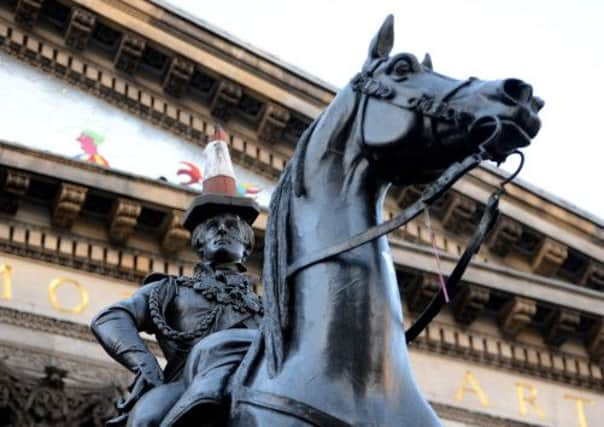Christine Jardine: Hats off for adorning statues


I have a mug which travels everywhere with me. It did a spell in Downing Street, has been to Inverness and is now resident in Aberdeen.
My mug bears a picture of the Duke of Wellington’s statue wearing his cone hat. I keep it close to remind me of what I love most about the city of my birth: its sense of humour.
And I’m not alone.
Advertisement
Hide AdAdvertisement
Hide AdThere are emigré Glaswegians all over this country and others with photographs, pictures and mugs adorned with one of Britain’s greatest military figures sitting proudly astride his horse and wearing a jauntily-angled traffic cone. I’ve even given a print of the image as a wedding present.
It’s a joke generations of the city’s own folk, and tourists, have now both enjoyed and conspired in.
We’ve all witnessed a council employee on a cherry-picker remove the offending headgear, only for it to be replaced the minute his vehicle disappears out of sight around the corner.
So the fact that the city leaders’ attempts to thwart the mischief by raising the duke’s plinth provoked such outrage should have come as no surprise. Not just because telling Glaswegians what they cannot do is never a recipe for success, but because for many people it showed a complete lack of appreciation of the genuine affection for an otherwise unremarkable figure of a man on a horse.
Not to mention a serious sense of humour failure. It’s not as if Glasgow is alone in its irreverent attitude to bronze representations of past heroes.
There’s a statue in the centre of Tain in Easter Ross which regularly wears a red and white titfer very similar to the Duke’s.
Come New Year’s morning 2014, I’m sure there will be bronze replicas of important figures all over the country wearing different garb from what they had on Hogmanay.
I’ve seen Burns wearing a bunnet, Scott in a scarf and even a neighbourhood garden statue with a brand new Santa hat.
Advertisement
Hide AdAdvertisement
Hide AdPerhaps a better known example is the shiny toe on David Hume’s figure in Edinburgh. It has long been part of a tradition amongst philosophy students in the capital to rub his foot for luck on the way to their finals.
I’m sure even the somewhat foreboding figure of Queen Victoria looking out to Royal Deeside from Aberdeen’s Queen’s Cross has taken part in this particular frivolity.
Well, perhaps that last one is doubtful. It’s more likely to have been either William Wallace in Rosemount or Burns in Union Terrace, but should our interactions with our cities’ statues not, in fact, be seen as a positive phenomenon?
Perhaps even a curious type of civic pride?
After all, in Brussels they do it officially. The world-famous Manneken-Pis actually has a series of costumes – 800 in total – to wear on special occasions.
Many have been gifted by national, or international, organisations keen to be associated with the figure which, let’s be frank, the po-faced among us could say is a setting a bad example by making a hero of a little boy urinating in public.
But the Manneken’s habit and dress are so revered that his wardrobe even has its own exhibit in the Museum of the City of Brussels and is widely regarded as an important part of the heritage of the Belgian capital.
We now regularly use our best-known landmarks – including Buckingham Palace – as the backgrounds for light shows. Surely the closing ceremony of the 2012 Olympics would have been poorer without the projection of different exterior and interiors which accompanied the performance by Madness? It’s all part of the same thing. We are having fun.
And as for it not being respectful: the Nepalese marked the 60th anniversary of the first recorded ascent of Mount Everest by decorating the statues of Sir Edmund Hillary and Sherpa Tenzing Norgay with orange garlands. It was a way of showing them respect.
Advertisement
Hide AdAdvertisement
Hide AdIn many religions, too, statues and images are decorated to mark important dates and holidays. But before someone accuses me of elevating a joke to the same level as religious adoration – I am not.
I am simply saying that, as long as our statues are not damaged or the decoration is not offensive, what harm can it possibly do?
The damage to the late Donald Dewar’s statue in Buchanan Street and repeated removal of his glasses crossed that line…but generally speaking, adorning statues with anything is a sign of respect, adoration or simply fun.
There can also, of course, be a practical benefit – education. How many people would know, or even care, who the military guy on the horse was or which building he was outside if not for the iconic significance his headgear has given him? Who knows how many tourists’ attention has been drawn to, or even into, Glasgow’s Gallery of Modern Art by his eye-catching presence?
People who might otherwise know nothing of the Duke of Wellington notice and inquire why he has a statue in Scotland, far less Glasgow.
I’m embarrassed to admit that when my Aberdonian husband asked me that very question the only answer I could offer was: “So we have somewhere to put the traffic cone.”